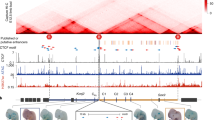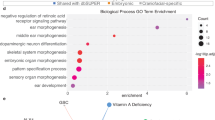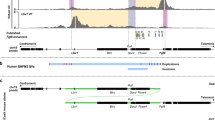Abstract
Rieger syndrome (REG) is an autosomal–dominant human disorder that includes anomalies of the anterior chamber of the eye, dental hypoplasia and a protuberant umbilicus. We report the human cDNA and genomic characterization of a new homeobox gene, RIEG, causing this disorder. Six mutations in RIEG were found in individuals with the disorder. The cDNA sequence of Rieg, the murine homologue of RIEG, has also been isolated and shows strong homology with the human sequence. In mouse embryos Rieg mRNA localized in the periocular mesenchyme, maxillary and mandibular epithelia, and umbilicus, all consistent with RIEG abnormalities. The gene is also expressed in Rathke's pouch, vitelline vessels and the limb mesenchyme. RIEG characterization provides opportunities for understanding ocular, dental and umbilical development and the pleiotropic interactions of pituitary and limb morphogenesis.
This is a preview of subscription content, access via your institution
Access options
Subscribe to this journal
Receive 12 print issues and online access
$209.00 per year
only $17.42 per issue
Buy this article
- Purchase on Springer Link
- Instant access to full article PDF
Prices may be subject to local taxes which are calculated during checkout
Similar content being viewed by others
References
Murray, J.C. Face facts: genes, environment, and clefts. Am. J. Hum. Genet. 57, 227–232 (1995).
Winter, R. What's in a face? Nature Genet. 12, 124–129 (1996).
Collins, F.S. Positional cloning moves from perditional to traditional. Nature Genet. 9, 347–350 (1995).
Krumlauf, R. Hox genes in vertebrate development. Cell 78, 191–201 (1994).
Sanyanusin, P. et al. Mutation of the PAX2 gene in a family with optic nerve colobomas, renal anomalies, and vesicoureteral reflux. Nature Genet. 9, 358–363 (1995).
Baldwin, C.T., Hoth, C.F., Amos, J.A., da-Silva, E.O. & Milunsky, A. An exonic mutation in the HuP2 paired domain gene causes Waardenburg's syndrome. Nature 355, 637–638 (1992).
Glaser, T., Walton, D.S. & Maas, R.L. Genomic structure, evolutionary conservation and aniridia mutations in the human PAX6 gene. Nature Genet. 2, 232–238 (1992).
Jabs, E.W. et al. A mutation in the homeodomain of the human MSX2 gene in a family affected with autosomal dominant craniosynostosis. Cell 75, 443–450 (1993).
Vastardis, H., Karimbux, N., Guthua, S.W., Seidman, J.G. & Seidman, C.E. A human MSX1 homeodomain missense mutation causes selective tooth agenesis. Nature Genet. 13, 417–421 (1996).
Muragaki, Y., Mundlos S., Upton J. & Olsen B.J. Altered growth and branching patterns in synpolydactyly caused by mutations in HOXD13. Science 272, 548–551 (1996).
Brunelli, S. et al. Germline mutations in the homeobox gene EMX2 in patients with severe schizencephaly. Nature Genet. 12, 94–96 (1996).
Pfäffte, R.W. et al. Mutation of the POU-specific domain of Pit-1 and hypopituitarism without pituitary hypoplasia. Science 257, 1118–1121 (1992).
Vossius, A. Kongenitaleanomalien der iris. Kiln. Mbl. Augenheilk 21, 233–237 (1883).
Darwin, C. Animals and plants under domestication 1, chapter 12, 434–461 (D. Appteton & Co, New York, 1893).
Rieger, H. Dysgenesis mesodermaiis coreneal et iridis. Z. Augenheik 86, 333 (1935).
Murray, J.C. et al. Linkage of Rieger syndrome to the region of the epidermal growth factor on chromosome 4. Nature Genet. 2, 46–49 (1992).
Phillips, J.C. et al. A second locus for Rieger syndrome maps to chromosome 13q14. Am. J. Hum. Genet. 59, 613–619 (1996).
Slavkin, H.C. Rieger syndrome revisited: experimental approaches using phamiacologic and antisense strategies to abrogate EGF and TGF-a functions resulting in dysmorphogenesis during embryonic mouse crantofacial morphogenesis. Am. J. Med. Genet. 47, 689–697 (1993).
Datson, N. et al. Closing in on the Rieger syndrome gene on 4q25: mapping translocation breakpoints wrthin a 50-kb region. Am. J. Hum. Genet, (in the press).
Semina, E. et al. Exclusion of epidermal growth factor (EGF) and high-resolution physical mapping across the Rieger syndrome locus. Am. J. Hum. Genet, (in the press).
Padanilam, B.J. et al. Characterization of the human HOX7 cDNA and identification of polymorphic markers. Hum. Mol. Genet. 1, 407–410 (1992).
Kozak, M. Interpreting cDNA sequences: some insights from studies on translation. Mamm. Genome 7, 563–574 (1996).
Lamonerie, T. et al. Ptx1, a bicoid-related homeo box transcription factor involved in transcription of the pro-opiomelanocortin gene. Genes Dev. 10, 1284–1295 (1996).
Szeto, D.P., Ryan, A.K., O'Connell, S.M. & Rosenfeld, M.G. P-OTX: A PIT-1-interacting homeodomain factor expressed during anterior pituitary gland development. Proc. Natl. Acad. Sci. USA 93, 7706–7710 (1996).
Hanes, S.D. & Brent, R. DNA specificity of the bicoid activator protein is determined by homeodomain recognition helix residue 9. Cell 57, 1275–1283 (1989).
Jin, Y., Hoskins, R. & Horvitz, H.R. Control of type-D GABAergic neuron differentiation by C. elegans UNC-30 homeodomain protein. Nature 372, 780–783 (1994).
Simeone, A. et al. A vertebrate gene related to ortnodenticle contains a homeodomain of the bicoid class and demarcates anterior neuroectoderm in the gastrulating mouse embryo. EMBO J. 12, 2735–2747 (1993).
Hanes, S.D., Riddihough, G., Ish-Horowicz, D. & Brent, R. Specific DNA recognition and intersite spacing are critical for action of the bicoid morphogen. Mol. Cell Biol. 14, 3364–3375 (1994).
Nohno, T. et al. A chicken homeobox gene related to Drosophila paired is predominantly expressed in the developing limb. Dev. Biol. 158, 254–264 (1993).
Leussink, B. et al. Expression patterns of the paired-related homeobox genes Mhox/Prx1 and S8/Prx2 suggest roles in development of the heart and forebrain. Mech. Dev. 52, 51–64 (1995).
Zhao, G.Q., Eberspaecher, H., Seldin, M.F. & de Crombrugghe, B. The gene for the homeodomain-containing protein Cart-7 is expressed in cells that have a chondrogenic potential during embryonic development. Mech. Dev. 48, 245–254 (1994).
Schneta, K., Spielmann, p., & Noll, M. Molecular genetics of aristaless, a prd-type homeo box gene involved in the morphogenesis of proximal and distal pattern elements in a subset of appendages in Drosophila . Genes Dev. 7, 114–129 (1993).
Saito, T., Greenwood, A., Sun, Q. & Anderson, D.J. Identification by differential RT-PCR of a novel paired homeodomain protein specifically expressed in sensory neurons and a subset of their CNS targets. Mol. Cell. Neurosci. 6, 280–292 (1995).
Liu, I.S. et al. Developmental expression of a novel murine homeobox gene (Chx10): evidence for roles in determination of the neuroretina and inner nuclear layer. Neuron 13, 377–393 (1994).
Simeone, A. et al. Ortnopedia, a novel homeobox-containing gene expressed in the developing CNS of both mouse and Drosophila. Neuron 13, 81–101 (1994).
Shapiro, M.B. RNA splice junctions of different classes of eukaryotes: sequence statistics and functional implications in gene expression. Nucl. Adds Res. 15, 7155–7174 (1987).
Reed, R. The organization of 3′ splice-site sequences in mammalian introns. Genes Dev. 3, 2113–2123 (1989).
Bedell, M.A., Jenkins, N.A. & Copeland, N.G. Good genes in bad neighbourhoods. Nature Genet. 12, 229–232 (1996).
Berieth, T. et al. The role of localization of bicoid RNA in organizing the anterior pattern of the Drosophila embryo. EMBO J. 7, 1749–56 (1988).
Simmons, D.M. et al. Pituitary cell phenotypes involve cell-specific Pit-1 mRNA translation and synergistic interactions with other classes of transcription factors. Genes Dev. 4, 695–711 (1990).
Feingold, M., Shiere, F., Fogels, H.R. & Donaldson, D. Rieger's syndrome. Pediatr. 44, 564–569 (1969).
Sadeghi-Nejad, A. & Senior, B. Autosomal dominant transmission of isolated growth hormone deficiency in iris-dental dysplasia (Rieger's syndrome). J. Pediatr. 85, 644–648 (1974).
Treisman, J., Harris, E., Wilson, D. & Desplan, C. The homeodomain: a new face for the helix-turn-helix?. BioEssays 14, 145–150 (1992).
Asson-Batres, M.A., Spurgeon, S.L., Diaz, J. deLoughery, T.G. & Bagby, G.C. Evolutionary conservation of the AU-rich 3′ untranslated region of messenger RNA. Proc. Natl. Acad. Sci. USA 91, 1318–1322 (1994).
Beelman, C.A. & Parker, R. Degradation of mRNA in eukaryotes. Cell 81, 179–183 (1995).
Dubnau, J. & Struhl, G. RNA recognition and translational regulation by a homeodomain protein. Nature 379, 694–699 (1996).
Heon, E. et al. Linkage of autosomal dominant iris hypoplasia to the region of the Rieger syndrome locus (4q25). Hum. Mol. Genet. 4, 1435–1439 (1995).
Alkemade, P.P.H. Dysgenesis mesodermaiis of the iris and the cornea: a study of Rieger's syndrome and Peter's anomaly (Charles C. Thomas, Assen, Netherlands, 1969).
MacKenzie, A., Ferguson, M.W.J. & Sharpe, R.T. Expression patterns of the homeobox gene, Hox-8, in the mouse embryo suggest a role in specifying tooth initiation and shape. Development 115, 403–420 (1992).
Krespi, Y.P. & Pertsemlidis, D. Rieger's syndrome associated with a large Meckel's diverticulum. Am. J. Gastroenter. 71, 608–610 (1979).
Rogers, R.C. Rieger syndrome. Proc. Greenwood Genet. Center 7, 9–13 (1988).
Crawford, R.A.D. Iris dysgenesis with other anomalies. Brit. J. Ophthalmol. 51, 438–440 (1967).
Fitch, N. & Kaback, M., Axenfeld syndrome and the Rieger syndrome. J. Med. Genet. 15, 30–34 (1978).
Eiberg, H., Bixler, B., Nielsen, L.S., Coneally, P.M. & Mohr, J. Suggestion of linkage of a major locus for nonsyndromic orofacial cleft with F13A and tentative assignment to chromosome 6. Clin. Genet. 32, 129–132 (1987).
Moore, G.E. et al. Linkage of an X-chromosome cleft palate gene. Nature 326, 91–92 (1987).
Murray, J.C. et al. Linkage of an autosomal dominant clefting syndrome (Van der Woude) to loci on chromosome 1q. Am. J. Hum. Genet. 46, 486–491 (1990).
Muenke, M. et al. Linkage of human brain malformation, familial holoprosencephaly, to chromosome 7 and evidence for genetic heterogeneity. Proc. Nat. Acad. Sci. USA 91, 8102–8106 (1994).
Tassabehji, M. et al. Waardenburg's syndrome patients have mutations in the human homologue of the Pax-3 paired box gene. Nature 355, 635–636 (1992).
Dixon, J. et al. Positional cloning of a gene involved in the pathogenesis of Treacher Collins syndrome. Nature Genet. 12, 130–136 (1996).
Slaney, S.F. et al. Differential effects of FGFR2 mutations on syndactyly and cleft palate in Apert syndrome. Am. J. Hum. Genet. 58, 923–932 (1996).
Pasteris, N.G. et al. Isolation and characterization of the faciogenital dysplasia (Aarskog-Scott syndrome) gene: a putative Rho/Rac guanine nucleotide exchange factor. Cell 79, 669–678 (1994).
Gasser, D.L., Goldner-Sauve, A., Katsuma, M. & Goldman, A.S. Restriction fragment length polymorphisms, glucocorticoid receptors, and phenytoin-induced cleft palate in congenic strains of mice with serious susceptibility differences. J. Craniofac. Genet. Dev. Bio. 11, 366–371 (1991).
Karoiyi, J. & Erickson, R.R. A region of the mouse genome homologous to human chromosome 1 q21 affects facial clefting. J. Craniofac. Genet. Dev. Bio. 13, 1–5 (1993).
Satokata, I. & Maas, R. Msx1 deficient mice exhibit cleft palate and abnormalities of craniofacial and tooth development. Nature Genet. 6, 348–356 (1994).
Juriloff, D.M. & Mah, D.G. The major locus for multifactorial nonsyndromic cleft lip maps to mouse chromosome 11. Mamm. Genome 6, 63–69 (1995).
Kaartinen, V. et al. Abnormal lung development and cleft palate in mice lacking TGF- β3 indicates defects of epitnelial-mesenchymal interaction. Nature Genet. 11, 415–421 (1995).
Proetzel, G. et al. Transforming growth factor- β3 is required for secondary palate fusion. Nature Genet. 11, 409–414 (1995).
Qiu, M. et al. Null mutation of Dlx-2 results in abnormal morphogenesis of proximal first and second branchial arch derivatives and abnormal differentiation in the forebrain. Genes Dev. 9, 2523–2538 (1995).
Lindsay, S. & Bird, A.P. Use of restriction enzymes to detect potential gene sequences in mammalian DNA. Nature 327, 336–338 (1987).
Theiler, K., Atlas of Embryonic Development (Springer-Veriag, New York, 1989).
Sassoon, D. & Rosenthal, N. Detection of messenger RNA by in situ hybridization. Meth. Enzymol. 225, 384–404 (1993).
Harland M. H. & Richard, M. H. In situ hybridization: an improved whole-mount method for Xenopus embryos. Meth. Cell Biol. 36, 685–695, Appendix G (1991).
Author information
Authors and Affiliations
Rights and permissions
About this article
Cite this article
Semina, E., Reiter, R., Leysens, N. et al. Cloning and characterization of a novel bicoid-related homeobox transcription factor gene, RIEG, involved in Rieger syndrome. Nat Genet 14, 392–399 (1996). https://doi.org/10.1038/ng1296-392
Received:
Accepted:
Issue Date:
DOI: https://doi.org/10.1038/ng1296-392
This article is cited by
-
A missense mutation in Pitx2 leads to early-onset glaucoma via NRF2-YAP1 axis
Cell Death & Disease (2021)
-
Pitx genes in development and disease
Cellular and Molecular Life Sciences (2021)
-
Surgical outcomes of Glaucoma associated with Axenfeld-Rieger syndrome
BMC Ophthalmology (2020)
-
Axenfeld–Rieger Syndrome: Rare Case Presentation and Overview
Journal of Maxillofacial and Oral Surgery (2020)



